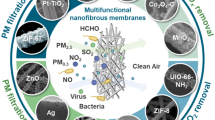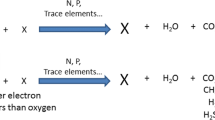Abstract
The relevance to the in vivo situation of in vitro toxicity studies of complex atmospheres has frequently been limited by the procedures used for the exposure of the biological samples. We have evaluated from on-road measurements the size distribution pattern and the subsequent respiratory tract deposition rates of particulate matter from urban atmospheric aerosols, which are in the range of 110 and 3 pg/cm2 per min for tracheobronchial and alveolar areas, respectively. Continuous flow-through rotating chambers and a specific design for exhaust sampling and dilution with controlled adjustment of pO2 and pCO2 to 20% and 5%, respectively, have been developed to expose biphasic air/liquid organotypic cultures of rat lung slices to continuous flows of diluted exhausts from diesel engines with preservation of the physicochemical properties of the exhaust. The size distribution of the particulate matter and the bioavailability of pollutants were preserved, thus allowing us to closely mimic in vitro the in vivo atmosphere/tissue interactions that occur mainly through diffusion mechanisms. The toxicity response profile has been assessed in terms of tissue viability, oxidative stress, DNA injury, and the early phase of inflammatory reaction. Exhaust filtration, addition to fuel of rapeseed methyl ester, and preincubation of lung tissue with soy isoflavones modulated the toxicity response profile of exhausts. The importance of preserving both particulate matter size distribution and adsorbed pollutant bioavailability, which could not be ascertained using more classical in vitro approaches, is discussed and should be considered a prerequisite for further developments of in vitro studies to modelize in vivo inhalation of complex atmospheres.
Similar content being viewed by others
References
Abe S, Takizawa H, Sugawara I, Kudoh S. Diesel exhaust (DE)-induced cytokine expression in human bronchial epithelial cells: a study with a new cell exposure system to freshly generated DE in vitro. Am J Respir Cell Mol Biol. 2000; 22: 296–303.
Aebi H, Wyss SR, Scherz B, Skvaril F (1974) Heterogeneity of erythrocyte catalase II. Isolation and characterization of normal and variant erythrocyte catalase and their subunits. Eur J Biochem. 1994; 48: 137–45.
Adamson IY, Bowden DH. Dose response of the pulmonary macrophagic system to various particulates and its relationship to transepithelial passage of free particles. Exp Lung Res. 1981; 2: 165–75.
Bayram H, Devalia JL, Sapsford RJ, et al. The effect of diesel exhaust particles on cell function and release of in£amma-tory mediators from human bronchial epithelial cells in vitro. Am J Respir Cell Mol Biol. 1998; 18: 441–8.
Becker S, Soukup JM, Gilmour MI, Devlin RB. Stimulation of human and rat alveolar macrophages by urban air particulates: effects on oxidant radical generation and cytokine production. Toxicol Appl Pharmacol. 1996; 141: 637–48.
Boland S, Baeza-Squiban A, Fournier T, et al. Diesel exhaust particles are taken up by human airway epithelial cells in vitro and alter cytokine production. Am J Physiol. 1999; 276: 604–13.
Boland S, Bonvallot V, Fournier T, Baeza-Squiban A, Aubier M, Marano F. Mechanisms of GM-CSF increase by diesel exhaust particles in human airway epithelial cells. Am J Physiol Lung Cell Mol Physiol. 2000; 278: L25–32.
Boland S, Baeza-Squiban A, Bonvallot V, et al. Similar cellular effects induced by diesel exhaust particles from a representative diesel vehicle recovered from ¢lters and Standard reference material 1650. Toxicol In Vitro 2001; 15: 379–85.
Bond JA, Wolff RK, Harkema JR, et al. Distribution of DNA adducts in the respiratory tract of rats exposed to diesel exhaust. Toxicol Appl Pharmacol. 1988; 96: 336–46.
Bond JA, Johnson NF, Snipes MB, Mauderly JL DNA adduct formation in rat alveolar type II cells: cells potentially at risk for inhaled diesel exhaust. Environ Mol Mutagen. 1990; 16: 64–9.
Bonvallot V, Baeza-Squiban A, Baulig A, et al. Organic compounds from diesel exhaust particles elicit a proin£am-matory response in human airway epithelial cells and induce cytochrome p4501A1 expression. Am J Respir Cell Mol Biol. 2001; 25: 515–21.
Crapo JD, McCord JM, Fridovitch I. Preparation and assay of superoxide dismutases. Methods Enzymol. 1978; 53: 382–93.
Dorries AM, Valberg PA. Heterogeneity of phagocytosis for inhaled versus instilled material. Am Rev Respir Dis. 1992; 146: 831–7.
EPA. Air quality criteria for particulate matter. EPA/600/P-001L volume II; April 1996.
Gallagher J, George M, Kohan M, Thompson C, Shank T, Lewtas J. Detection and comparison of DNA adducts after in vitro and in vivo diesel emission exposures. Environ Health Perspect. 1993; 99: 225–8.
Ferin J, Oberdorster G, Penney DP. Pulmonary retention of ultra¢ne and ¢ne particles in rats. Am J Respir Cell Mol Biol. 1992; 6: 535–42.
Han JY, Takeshita K, Utsumi H. Noninvasive detection of hydroxyl radical generation in lung by diesel exhaust particles. Free Radic Biol Med. 2001; 30: 516–25.
Ito T, Ikeda M, Yamasaki H, Sagai M, Tomita T. Peroxinitrite formation by diesel exhaust particles in alveolar cells: link to pulmonary in£ammation. Environ Toxicol Pharmacol. 2000; 9: 1–8.
Kurzer MS, Xu X. Dietary phytoestrogens. Annu Rev Nutr. 1997; 17: 353–81.
Le Prieur E, Morin JP, Bion A, Dionnet F. Toxicity of diesel engine exhaust: induction of pro-in£ammatory response and apoptosis in an in vitro model of lung slices in bi-phasic organotypic culture. Arch Toxicol. 2000a; 74: 460–6.
Le Prieur E, Morin JP, Bion A, Gouriou F, Dionnet F. Toxicological impact of diesel fuel supplementation with rapeseed methylester (RME) on the lung toxic potential of diesel exhausts. SAE Technical Paper 2000–01-2060 2000b.
Li XY, Gilmour PS, Donaldson K, MacNee W. In vivo and in vitro proin£ammatory effects of particulate air pollution (PM10). Environ Health Perspect. 1997; 105(supplement 5): 1279–83.
Mauderly JL, Jones RK, McClellan RO, Henderson RF, Gri¤th WC. Carcinogenicity of diesel exhaust inhaled chronically by rats. Dev Toxicol Environ Sci. 1986; 13: 397–409.
Mistry P, Merazga Y, Spargo DJ, Riley PA, McBrien DC. The effects of cisplatin on the concentration of protein thiols and glutathione in the rat kidney. Cancer Chemo Pharmacol. 1991; 28: 277–82.
Monteil C, Guerbet M, Le Prieur E, Morin JP, Jouanny JP, Fillastre JP. Characterization of precision-cut lung slices in a bi-phasic gas/liquid exposure system: effect of O2. Toxicol In Vitro. 1999; 13: 467–73.
Morin JP, LePrieur E, Dionnet F, Robin L. The in£uence of a particle trap on the in vitro lung toxicity response to continuous exposure to diesel exhaust emission. SAE Technical Paper 1999–01-2710; 1999a.
Morin JP, Fouquet F, Monteil C, LePrieur E, Vaz E, Dionnet F. Development of a new in vitro system for continuous in vitro exposure of lung tissue to complex atmospheres: application to diesel exhaust toxicology. Cell Biol Toxicol. 1999b; 15: 143–52.
Osier M, Oberdorster G. Intratracheal inhalation vs intratracheal instillation: differences in particle effects. Fundam Appl Toxicol. 1997; 40: 220–7.
Rosenkranz HS. Revisiting the role of mutagenesis in the induction of lung cancers in rats by diesel emissions. Mutat Res. 1993; 303: 91–5.
Rumigny J-F. Soy iso£avones, a prospective insight from recent molecular data. Nafas Sci. 2001; 4: 3–30.
Salvi SS, Nordenhall C, Blomberg A, et al. Acute exposure to diesel exhaust increases IL-8 and GRO-alpha production in healthy human airways. Am J Respir Crit Care Med. 2000; 161: 550–7.
Smith LL, Wyatt I, Cohen GM. The accumulation of diamines and polyamines in rat lung slices. Biochem Pharmacol. 1982; 31: 3029–33.
Steerenberg PA, Zonnenberg JA, Dormans JA, et al. Diesel exhaust particles induced release of interleukin 6 and 8 by (primed) human bronchial epithelial cells (BEAS 2B) in vitro. Exp Lung Res. 1998; 24: 85–100.
Suarez S, Kazantseva M, Bhat M, Costa D, Hickey AJ. The in£uence of suspension nebulization or instillation on particle uptake by guinea pig alveolar macrophages. Inhal Toxicol. 2001; 13: 773–88.
Swafford DS, Nikula KJ, Mitchell CE, Belinsky SA. Low frequency of alterations in p53, K-ras, and mdm2 in rat lung neoplasms induced by diesel exhaust or carbon black. Carcinogenesis. 1995; 16: 1215–21.
Takano H, Yoshikawa T, Ichinose T, Miyabara Y, Imaoka K, Sagai M. Diesel exhaust particles enhance antigen-induced airway in£ammation and local cytokine expression in mice. Am J Respir Crit Care Med. 1997; 156: 36–42.
Vincent R, Kumarathasan P, Goegan P, etal. Inhalation toxicology of urban particulate matter: acute cardiovascular effects in rats. HEI Research report 104; October 2001.
Wendel A. Detoxi¢cation and drug metabolism; conjugation and related systems. Methods Enzymol. 1981; 77: 325–33.
Wiseman H. The therapeutic potential of phytoestrogens. Expert Opin Invest Drugs. 2000; 9: 1829–40.
Author information
Authors and Affiliations
Rights and permissions
About this article
Cite this article
Bion, A., Fall, M., Gouriou, F. et al. Biphasic culture of rat lung slices for pharmacotoxicological evaluation of complex atmospheres. Cell Biol Toxicol 18, 301–314 (2002). https://doi.org/10.1023/A:1019544416969
Issue Date:
DOI: https://doi.org/10.1023/A:1019544416969




